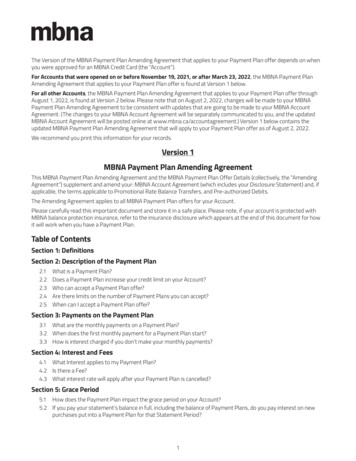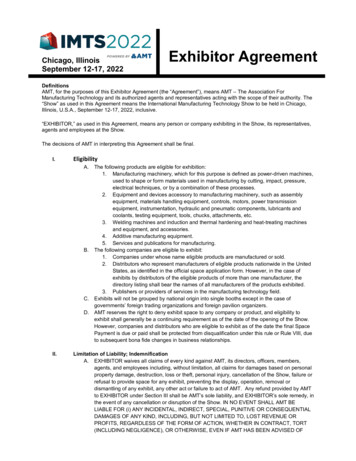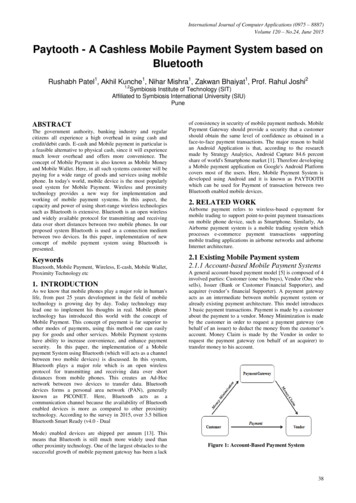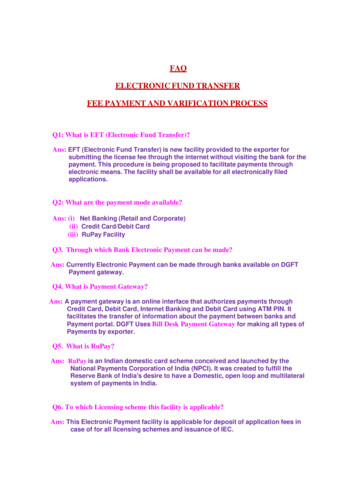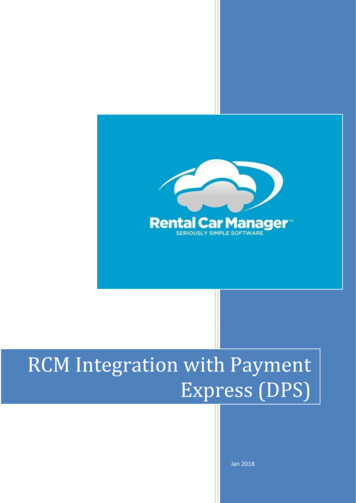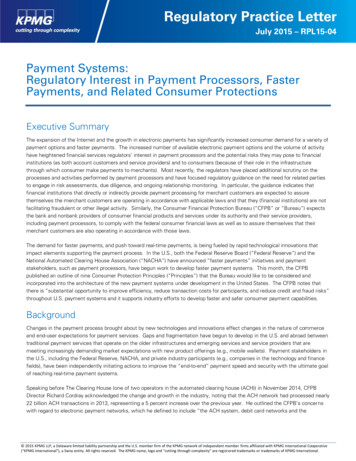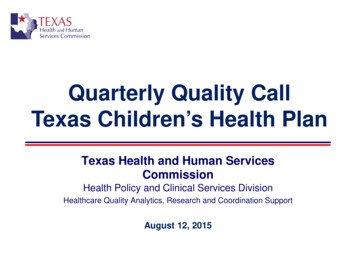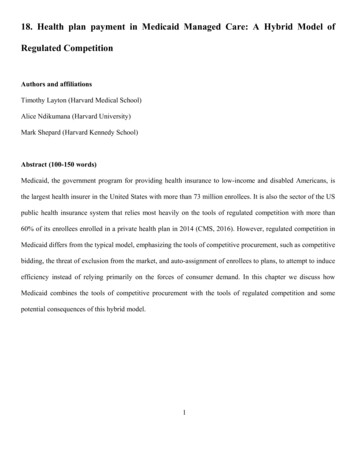
Transcription
18. Health plan payment in Medicaid Managed Care: A Hybrid Model ofRegulated CompetitionAuthors and affiliationsTimothy Layton (Harvard Medical School)Alice Ndikumana (Harvard University)Mark Shepard (Harvard Kennedy School)Abstract (100-150 words)Medicaid, the government program for providing health insurance to low-income and disabled Americans, isthe largest health insurer in the United States with more than 73 million enrollees. It is also the sector of the USpublic health insurance system that relies most heavily on the tools of regulated competition with more than60% of its enrollees enrolled in a private health plan in 2014 (CMS, 2016). However, regulated competition inMedicaid differs from the typical model, emphasizing the tools of competitive procurement, such as competitivebidding, the threat of exclusion from the market, and auto-assignment of enrollees to plans, to attempt to induceefficiency instead of relying primarily on the forces of consumer demand. In this chapter we discuss howMedicaid combines the tools of competitive procurement with the tools of regulated competition and somepotential consequences of this hybrid model.1
18.1. IntroductionMedicaid, the public program for providing low-income and disabled Americans with health insurancecoverage, is the largest payer for health care services in the United States. As of August 2016, over 73 millionAmericans (almost one quarter of the U.S. population) were enrolled in the Medicaid program (CMS 2016a). In2015 total Medicaid spending exceeded 550 billion (almost one-fifth of total U.S. healthcare spending) (TotalMedicaid Spending 2016).Unlike Medicare, a federal program that is nationwide and uniform across states, Medicaid is a joint statefederal program. The federal government provides substantial funding for the program and in return dictateswhich populations must be covered by a state’s Medicaid program and what benefits must be provided. States,in turn, have significant flexibility to cover additional populations and provide additional benefits. Importantlyfor this chapter, states can also choose whether to provide Medicaid benefits through a publicly managed feefor-service (FFS) program or to contract out the provision of Medicaid benefits to private managed careorganizations (MCOs), also known as Medicaid Managed Care (MMC) plans. Over time, states haveincreasingly moved toward managed care, with around 60% of Medicaid recipients enrolled in a privatemanaged care plan by 2014 (CMS 2016b). As part of these MMC programs, states often let individuals chooseamong multiple competing MMC plans and/or between a private MMC plan and a public FFS Medicaid plan –an arrangement similar to competition between private Medicare Advantage plans and Traditional Medicare.As in the other health insurance markets covered in this volume, Medicaid managed care exhibits somefeatures of regulated competition, though, as we explore below, MMC uses a unique and interesting flavor ofregulated competition that leverages procurement rules to introduce the forces of competition at the initialprocurement stage rather than at the level of consumer plan choice. In a sense, state Medicaid agencies can usetheir regulatory position to construct a low-cost, high-quality “network of health plans” – analogous to howhealth plans themselves attempt to construct low-cost, high-quality networks of healthcare providers.2
State experimentation with regulated competition in Medicaid began in the early 1970s, with Californialeading the way (Sparer 2012). Growth was slow until the “managed care revolution” of the 1990s whenmanaged care enrollment increased dramatically both in Medicaid and in other sectors of the U.S. healthinsurance market. However, managed care in Medicaid continued to grow dramatically even during thesubsequent “managed care backlash” in the late 1990s and 2000s. By 2014, 60% of Medicaid recipients wereenrolled in a private MMC plan (CMS 2016b). 1 Most of the initial enrollment in MMC was concentrated amongpregnant women, mothers, and children, but more recently MMC enrollment has been growing among aged,disabled, and chronically ill Medicaid recipients (MACPAC, 2011).In addition to the expansion of managed care enrollment, there has been an increase in the use of regulatedcompetition principles by MMC programs. Initially, when states adopted managed care, payments to healthplans were negotiated individually with each plan on an annual basis; risk adjustment was primitive and limitedto demographics and eligibility category; and “competition” consisted of one plan competing with the publicFFS plan. Today, plan payments are often either based on competitive bids or set administratively, moresophisticated risk adjustment is widely used, and competition among MMC plans is more robust in many areas.Increasingly, MMC programs look like traditional health insurance markets organized around the principles ofregulated competition – including markets like Medicare Advantage and national health insurance systems inthe Netherlands, Germany, and Switzerland.While MMC is adopting more features of regulated competition, its design is also rooted in its history as apublic program for the poor. In many ways, state Medicaid programs treat MMC plans as contractorsadministering welfare benefits rather than as competitors in a regulated health insurance market. This themeshows up in several ways in MMC programs. First, there are generally no premiums in Medicaid. The program1Often estimates of Medicaid managed care penetration of 70% or higher are cited by policymakers and researchers. The “greater than70%” estimates include additional forms of “managed care,” specifically the use of “primary care case management” (PCCM)programs. These programs are essentially government-run fee-for-service plans with bonuses to PCPs for each Medicaid PCCMenrollee in their panel. The use of this type of “managed care” arrangement does not fit the mold of regulated competition, and, thus,for the purpose of this chapter we do not count it as managed care.3
is largely free to recipients. While a few states have adopted nominal premiums for select (and small)populations, these premiums are charged for entry into Medicaid, not based on a recipient’s plan choice. Inother words, even when they exist, Medicaid premiums do not vary across plans. This implies that insurerscannot “pass through” any savings to Medicaid enrollees in the form of lower premiums. As we discuss below,this policy effectively rules out the standard form of price competition used in typical markets and which was akey principle of Enthoven and Kronick’s (1989) regulated competition model. Instead, this channels consumerdriven competition into the quality-dimension of the product. This forces state Medicaid agencies to employother tools, such as administrative rate-setting, exclusion of high price plans from the market, and autoassignment targeted to lower-price plans, to restrain spending growth.Second, most benefits (including cost sharing and covered services) are fixed across plans, following astate-specified schedule. Per federal rules, this schedule has minimal cost-sharing, removing demand-sideincentives from the insurer’s toolkit for encouraging efficient use of health care. This design is based on theidea that almost any cost sharing is considered “unaffordable” for indigent Medicaid recipients and therefore anundue barrier to accessing care. Insurers do, however, have flexibility to design medical provider networks(subject to minimum network adequacy rules), prescription drug formularies, and utilization review/caremanagement practices.Finally, health plan choice differs substantially from the traditional model of regulated competition. ManyMedicaid recipients fail to actively choose an MMC plan, leaving the state to administratively assign them toone – assignment which is often random or quasi-random. States often use this assignment policy as part of thecontracting process with MMC plans. A common policy is to use assignment to equalize market share,effectively ensuring all plans with a contract receive an adequate number of enrollees. More recently, stateshave also begun to experiment with assignment rules that are tied to elements of a plan’s bid such as the plan’scapitation rate or plan quality ratings.4
It is also important to understand that unlike Medicare, Medicaid differs substantially across states, makingit not one program but 52 programs (50 states D.C. and Puerto Rico). States differ both in whether they usemanaged care at all and in which features of regulated competition they adopt. For example, some states likeConnecticut do not contract with private managed care plans, relying exclusively on the public fee-for-serviceplan. This is becoming less common, however, with only ten states not enrolling a single Medicaid recipient ina private MMC plan in 2014 (CMS, 2016b). 2 On the other hand, states like New York have robust managedcare programs that use regulated competition principles like plan choice, open enrollment periods, and riskadjustment. Then there are states like Missouri, which uses administratively-set government payments to plansbut restricts entry to three plans per region via a competitive procurement process aimed at extracting thehighest level of quality out of the competing health plans. Using the state’s power over entry into the market asa tool to improve outcomes is an example of how procurement policy can shape competitive dynamics inMedicaid markets. This tool perhaps represents a new instrument to be considered in the “regulatedcompetition” toolkit. This can also be thought of a form of “selective contracting,” analogous to the way healthplans use the threat of exclusion from their provider networks to induce price competition among providers.Because of these significant differences across states, instead of going into great detail describing aparticular state’s payment system, below we attempt to describe broadly how plan payment works acrossdifferent types of states. The remainder of the chapter is organized as follows. Section 2 discusses theorganization of the MMC system. Section 3 discusses health plan payment design, and section 4 discusses the(very limited) research evaluating MMC plan payment. Section 5 concludes by discussing ongoing issues andreforms.2Throughout this chapter we do not consider state Programs of All-Inclusive Care for the Elderly (PACE) as comprehensive MedicaidManaged Care plans. This differs from the CMS definition.5
18.2. Organization of the health insurance systemThe organization of the Medicaid Managed Care (MMC) health insurance system is complex. State MMCprograms vary in plan design requirements, procurement methods, and plan options for beneficiaries. Eachstate, subject to federal regulations, defines a set of covered health services, allowable cost sharing amounts,and provider network adequacy requirements for participating managed care plans. Some states contract withany insurer that complies with its requirements. Other states are selective, contracting only with insurers thatwin a competitive procurement process on the basis of price and/or other features of plan bids, such as the useof alternative payment models, care management practices, and other state priorities. Prices (also known as“capitation rates”) paid by the state Medicaid program to insurers may be determined through the competitiveplan selection process or may be set administratively or through negotiation with private insurers.Once a menu of plans has been determined, Medicaid recipients either choose a plan or are assigned to aplan, following the regulations of their state. If recipients choose their plan, their choice may be influenced bymarketing, outreach programs, and brokers or “navigators” provided by Medicaid. In this section we willdiscuss plan design, procurement and choice in greater detail to provide an overview of how the MedicaidManaged Care health insurance market operates.18.2.1 Plan Design RegulationsState Medicaid programs determine which benefits must be covered by managed care plans. This decisionconsists of three components. First, states decide which services will be covered in their Medicaid programsbeyond the services required by the federal government (if any). Second, states decide who will provide theservices: a private MMC plan, a specialty MCO, or the state’s fee-for-service Medicaid program. Third, thestate chooses certain parameters regulating how managed care plans provide the services.6
Covered ServicesThe federal government defines a set of mandatory benefits that states are required to provide for Medicaidenrollees, outlined in Table 18.1a. For example, Early and Periodic Screening, Diagnostic, and Treatment(EPSDT) services are required for enrollees under 21 years of age to facilitate early identification and diagnosisof physical and mental disorders, as well as early initiation of the appropriate treatment. States are also requiredto provide pregnancy related services, including pre-natal care, delivery, post-partum care, and family planning.Federal rules prohibit cost sharing for both EPSDT and pregnancy-related services.States may elect to also provide optional benefits for Medicaid enrollees, listed in Table 18.1b. Whileprescription drug coverage is technically optional, all states provide the benefit, though 22 states requirenominal copayments for covered drugs (KFF, 2017a). Other notable optional benefits include adult dental,physical therapy and rehabilitation, and optometry. Federal regulations require that benefits are equivalentacross beneficiaries and across the state in duration, amount and scope (MACPAC, 2017).Managed Care Carve-OutsWhen states adopt managed care, they may not do so for all covered Medicaid services. Often, somecovered benefits are “carved out” of managed care plan contracts and instead provided and financed via aseparate insurance scheme, such as a limited benefit plan 3 or traditional FFS Medicaid. The most commonlycarved out benefits are prescription drugs, behavioral health, and dental services. Table 18.2 outlines whichstates carved out each of these services in 2014. States may carve out benefits that they conclude would be moreeffectively administered and financed outside of a comprehensive managed care plan. Carve-outs may also havethe beneficial property of protecting services that may be vulnerable to risk selection. Frank et al. (1996) andFrank et al. (2000) note that MMC plans have strong incentives to inefficiently ration services that are3States may contract with insurers to provide a subset of benefits or services to enrollees, such as behavioral health, transportation,dental or prescription drugs. These contracts, referred to as “limited benefit plans” or “prepaid health plans,” are generally paidthrough capitation. Enrollment into limited benefit plans may include managed care enrollees, fee for services enrollees, or both.7
predictably used by high-cost, unprofitable individuals. By removing these services from the MMC plancontracts and financing them separately, states can ensure access to these services is maintained under MMC.Behavioral health is the most prominent example of a service often carved out of managed care contracts.Specialized behavioral health providers are often separate from the rest of the health care system – such aspsychiatric hospitals or outpatient behavioral health clinics. Some professionals are non-physician health careproviders who specialize in behavioral health, such as clinical social workers and psychologists. This separatenature of the behavioral health system is one reason why states may carve out these services from MMC plans. 4While carving out behavioral health has been the norm in MMC, a growing number of states have reversedcourse, “carving in” behavioral health into MMC plan contracts. Among the 42 states that offered MMC plansin 2014, 16 states carved out behavioral health (CMS 2016b) whereas in 2010, 21 of 36 states offering MMCplans carved out behavioral health (Gifford 2011).States may also carve out benefits in response to federal policies. For example, prior to the Affordable CareAct (ACA), prescription drugs provided through MMC plans were not eligible for the Medicaid drug rebateprogram, which required pharmaceutical companies to provide substantial discounts to Medicaid programs. Asof 2010, the rebate program was expanded to include drugs financed through MMC, prompting some states(such as New York) to carve prescription drug coverage into managed care plan contracts (MACPAC, 2011;KFF 2011).Regulation of MMC Plan BenefitsPremiums and cost sharing are restricted to nominal levels in MMC plans, and prohibited for certainservices and populations. Medicaid serves low-income individuals and families, for whom cost sharing typicalin commercial insurance plans is perceived as unaffordable. Because of this, states impose maximum allowable4Behavioral health carve-outs are used in the private health insurance market as well. Large employers may contract separately with amanaged behavioral health organization. Alternatively, an employer sponsored health plan may subcontract with a managedbehavioral health organization.8
amounts for premiums and cost sharing that vary by service, income level, and beneficiary type, in accordancewith federal regulations. Cost sharing is prohibited for emergency services, family planning services,pregnancy-related services, or preventive services for children (Brooks 2016). Furthermore, the sum ofpremium and cost sharing liabilities cannot exceed 5% of a family’s income. (Medicaid and Children’s Health2013).Some cost sharing, however, is allowed in a few cases. For example, some states allow the use of variablecopayments for prescription drugs to steer beneficiaries to more cost effective drugs included on a preferreddrug list. Federal regulations limit the maximum allowable copay for prescription drugs to 4 for preferreddrugs and 8 for non-preferred drugs, though state limits may be more restrictive. MMC plans may also elect toinclude lower cost sharing than the maximum allowed by the state. As a result, cost sharing may vary betweenMMC plan offerings and the fee-for-service option, or between participating MMC plan offerings.While cost sharing is strictly regulated, MMC plans have more flexibility in other areas of plan benefitdesign. The most important area is provider network design. Medicaid plan provider networks are perceived assome of the narrowest in the American health insurance market (though hard evidence to support this perceptionis limited), indicating that MMC insurers use this tool to limit health care costs among their enrollees (Draper2004; Mershon 2016). In practice, the de facto networks for these plans may be even smaller than the set ofproviders listed in the network. A 2013 study by the US Department of Health and Human Services found thatabout half of listed providers in managed care networks did not offer appointments to enrollees (OIG 2014).Managed care plans are permitted to limit provider networks in accordance with network adequacystandards. Federal regulations require that all states define access standards for MMC plans to ensure thatenrollees have adequate and timely access to all covered services. States must also develop a plan to monitoraccess, including an external review of access standards. Network adequacy standards must require MMC plansto consider anticipated enrollment, utilization and geographic location when constructing their provider9
network. If a covered service cannot be delivered by an in-network provider, a managed care plan must coverthe service at an out-of-network provider with no additional cost to the beneficiary (OIG 2014).MMC plans are generally health maintenance organizations (HMO) which do not cover out-of-networkservices when an in-network provider is available. However, federal regulations require that MMC plans mustcover out-of-network care for emergency and family planning services, both of which are also exempt frompatient cost sharing. MMC plans are required to communicate which benefits may be obtained out-of-networkand how to obtain those benefits. For example, insurers may require prior authorization for non-emergencyservices obtained at an out-of-network provider when an in-network provider was not available. Out-of-networkproviders are prohibited from billing the patient for the difference between the amount reimbursed by the MMCplan and the provider’s customary charge. Additionally, payments to providers for out-of-network care are notgoverned by predetermined contracts. As a result, costly case-by-case negotiations between insurers andproviders may arise to determine reimbursement. The 2005 Deficit Reduction Act attempted to address thisissue by requiring providers to accept payments made for out-of-network emergency services at the equivalentMedicaid fee-for-service rate (Center for Medicaid and State Operations, 2006). Some states have establishedpolicies to govern reimbursement for non-emergency out-of-network payments as well. For example, in Florida,a Medicaid plan must reimburse an out-of-network provider the lesser of the Medicaid fee-for-service rate orthe provider’s customary charges (Lewin Group).Federal network adequacy regulations discussed so far leave states considerable flexibility to develop statespecific network adequacy standards, leading to significant variations across states. Common criteria fornetwork adequacy used by states include distance or time of travel to provider, availability of appointmentswithin a given time frame, and a defined ratio of providers to enrollees. Standards may or may not be specifieddifferently for different types of providers, such as a primary care provider (PCP) or obstetrician. Additionally,for a given network adequacy criterion, the exact requirement may vary significantly across states. For example,10
in 2013, among states that had a provision for the maximum enrollee-to-PCP ratio, the maximum allowed ratiovaried from 100 enrollees per PCP to 2,500 enrollees per PCP (OIG, 2014).18.2.2 Competitive ProcurementStates use varying procurement methods to select insurers for MMC programs. Some states contract withall insurers that meet specified requirements. Most states, however, use competitive procurement to selectinsurers on the basis of cost and/or other features of plan bids such as quality and proposals for fulfillingparticular state priorities such as the adoption of alternative models of provider payment. States generallycontract with MCOs for one to three years and may include an option for one year renewals. 5Table 18.3 indicates which states use competitive vs. non-competitive selection methods. In a competitiveprocurement model, states issue a request for proposals (RFP) that informs insurers about the Medicaid programrequirements and solicits a cost bid and/or a technical proposal from insurers. The cost bid may include factorssuch as the insurer’s historical financial performance, administrative costs, projected costs for deliveringMedicaid benefits, or a proposed capitation rate. States may communicate a range of acceptable (i.e.“actuarially sound”) capitation rate bids in the RFP. In some cases, the cost bid is used to determine thecapitation rate. Alternatively, some states use competitive procurement to select plans, but capitation rates areset administratively or through negotiation. 6 Next, the technical proposal outlines the insurer’s plan fordelivering covered services in accordance with the state’s regulations, incorporating information on providernetworks and alternative provider payment models (e.g., use of medical homes or Accountable CareOrganizations). Bids are reviewed by state Medicaid programs, and insurers are selected using state-specificrubrics that weigh the cost bid and technical proposal. 75For instance, Florida and Missouri have used one year contracts with two one-year renewals for a total contract length of three years.Virginia has used one year contracts.6More details on rate-setting methods are provided in Section 18.3.7In some states, such as Missouri, the MMC plan bids do not include a cost bid, thereby focusing the bid entirely on the technicalproposal.11
The insurers that participate in MMC programs vary significantly in size, scope, and structure. Prior to1997, there was a “75/25” rule that required MMC insurers have at least 25 percent of their membership in theprivate, commercial health insurance market. The Balanced Budget Act of 1997 eliminated the “75/25” rule,making it possible for Medicaid-only insurers to participate (MACPAC, 2011). This flexibility has led to therise of insurers like Centene and Molina that focus almost exclusively on the MMC market. Nonetheless, moretraditional, predominantly commercial insurers continue to participate in Medicaid managed care (KFF 2017b).For example, in 2016, Aetna and United Healthcare have MMC contracts with 12 and 22 states, respectively(KFF, 2017b). Insurers also vary by geographic scope, with some operating in a single state or region (or evenmetropolitan area) and others operating across states.Another notable feature of Medicaid managed care insurance markets is the prevalence of small, localprovider-owned insurers. Some safety-net hospitals and community health centers, which serve a high share oflow-income, Medicaid-eligible patients, also operate MMC plans. These plans may operate within relativelysmall geographic areas – e.g., Metroplus in New York City or Chinese Community Health Plan (CCHP) in SanFrancisco. While providers have entered the insurance market with Medicaid plans, some Medicaid insurershave likewise entered the provider market by building their own health centers in areas with a high density ofMedicaid eligibility. Examples of these are Trusted Health Plan in the District of Columbia and L.A. Care inLos Angeles18.2.3 Plan ChoicePlan choice in Medicaid varies significantly across states on a variety of dimensions. First, the enrollmentoptions available to Medicaid beneficiaries vary by state and beneficiary type. Table 18.3 shows how theseenrollment options vary across states. Medicaid beneficiaries are either (a) required to enroll in a managed careplan (“mandatory”), (b) given a choice between MMC and the publicly managed FFS Medicaid program(“voluntary”), or (c) excluded from MMC (“not eligible”). Federal rules require states that use MMC to provideMedicaid recipients with some form of choice, either between FFS and MMC or among different MMC plans.12
In the 1990s, Medicaid managed care served mainly low-income children and families, often via mandatoryenrollment but sometimes as a voluntary choice. Aged and disabled Medicaid beneficiaries, who tend to havemore complex health needs, were generally served by FFS Medicaid. More recently, states have started to enrollaged and disabled beneficiaries into managed care plans (MACPAC, 2011). Table 18.3 indicates that of the 42states with Medicaid managed care programs in 2014, 28 of them required all disabled Medicaid recipients toenroll in an MMC plan.Second, the enrollment process varies by state and recipient type. In some states, all new enrollees are preassigned to a managed care plan and then given a period of time during which they are allowed to switch. Inothers, there is an initial enrollment choice period (just after eligibility verification) for new enrollees to select aplan. During this choice period, recipients are covered by the FFS program. After the choice period, enrolleeswho do not make an active plan choice are “auto-assigned” to a plan using algorithms that vary by state. Thisenrollment process varies across states and within a state by recipient type. For example, pregnant women inLouisiana are pre-assigned, whereas other beneficiaries have a 30-day enrollment choice period.In many states, auto-assignment –using an algorithm to automatically enroll Medicaid recipients who donot actively choose a plan in a (typically randomly) selected plan – is very common. A recent survey of stateMedicaid programs found that the median state has an auto-assignment rate of 45%, with the auto-assignmentrates for ten states exceeding 60% (Smith 2016). Auto-assignment algorithms are required to consider existingprovider-patient relationships and may also consider geographic location and enrollment of family members. Insome states, preferential auto-assignment rewards plans with superior cost or quality performance. In manystates, however, preferential auto-assignment focuses on balancing market shares across MMC plans – i.e.,assigning more enrollees to the plans that fewer people have actively chosen. 8 If enrollment in managed care is8This policy therefore rewards plans that – based on revealed preference in enrollees’ active plan choices – appear to be less desirable.While this policy seems odd, it is consistent with the theme of MMC plans as contractors or partners in administering a welfareprogram (rather than competitors in a market). Auto-assigning more enrollees to smaller plans helps prop up these insurers, makingthem more likely to succeed and giving them more leverage in contract negotiations with providers.13
not mandatory, enrollees who do not make a plan selection may instead be enrolled in FFS Medicaid. 9 Once theinitial plan assignment has been made, enrollees are often given a period of time to freely switch plans, afterwhich they are often ‘locked-in’ to a managed care plan for 6-12 months. However, the allowed time whenenrollees can switch plans also varies across states. Even during the “open enrollment” period during whichrecipients can switch plans, assignments are relatively “sticky,” with low levels of switching. However,switching is more likely among sicker recipients who t
Medicaid Spending 2016). . state-specified schedule. Per federal rules, this schedule hasminimal cost-sharing, removing demand side - . State Medicaid programs determine which benefits must be covered by managed care plans. This decision consists of three components. First, states decide services will be which covered in their Medicaid programs
